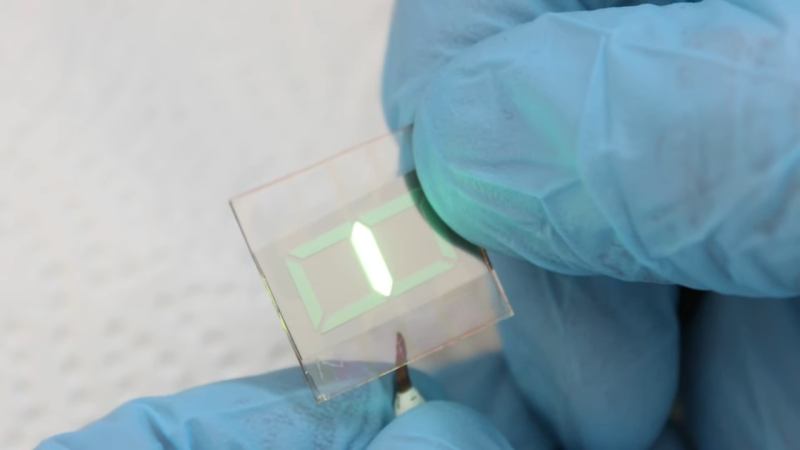Just a general observation: when your project’s BOM includes ytterbium metal, chances are pretty good that it’s something interesting. We’d say that making your own OLED displays at home definitely falls into that category.
Of course, the making of organic light-emitting diodes requires more than just a rare-earth metal, not least of which is the experience in the field that [Jeroen Vleggaar] brings to this project. Having worked on OLEDs at Philips for years, [Jeroen] is well-positioned to tackle the complex process, involving things like physical vapor deposition and the organic chemistry of coordinated quinolones. And that’s not to mention the quantum physics of it all, which is nicely summarized in the first ten minutes or so of the video below. From there it’s all about making a couple of OLED displays using photolithography and the aforementioned PVD to build up a sandwich of Alq3, an electroluminescent organic compound, on a substrate of ITO (indium tin oxide) glass. We especially appreciate the use of a resin 3D printer to create the photoresist masks, as well as the details on the PVD process.
The displays themselves look fantastic — at least for a while. The organic segments begin to oxidize rapidly from pinholes in the material; a cleanroom would fix that, but this was just a demonstration, after all. And as a bonus, the blue-green glow of [Jeroen]’s displays reminds us strongly of the replica Apollo DSKY display that [Ben Krasnow] built a while back.
















I wonder could probably be made even better with a Getter and seal made Wood’s metal or Field’s metal. But I guess you would need some low temperature alloy that can wet the glass for a really good seal.
(ref : https://en.wikipedia.org/wiki/Getter and https://en.wikipedia.org/wiki/Field%27s_metal )
Would potassium nitrate fill the pinholes? (Like gorilla glass). I don’t know enough about chemistry to answer my own (probably dumb) question.
100In would work.
integrating solar power and 365 day 24h screen will be great
Wow! My brain hurts! This video is so informative. 20 min. of pure OLED information.
Indeed, high spectral intensity bridging the divide equally between reality and idea/ideals ;-)
A nice tidbit at the end “devices made to last for eternity aren’t necessarily good for business”.
Previously: https://hackaday.com/2014/03/02/making-oleds-in-the-kitchen-sink/
Yep, I store my turbomolecular pump right next to screwdrivers in my home lab. Have to move it recently to make room for small 1.9GW tokamak I borrow from my neighbor.
I do the same, my flux capacitor will be done next week (the prototype is/was finished 25 years from now), so I will have to move a few things around to make room for ithe portable 1.21 GW generator.
Great Scott! Tell Jennifer we need to correct power deficiency right away!
You turn out okay but something needs to be done about your kids !
Absolutely fascinating! I wish more researchers, engineers or technicians share their knowledge as much and as well as this guy!
Not only for us to learn, but also simply to preserve memory of these technologies and skills to be lost with time passing by…
By the way, i wonder what are the differences with these russian electroluminescent display devices: http://www.155la3.ru/electroluminescent.htm
Those russian ones use AC high voltage, and my understanding is that they act like a capacitor. So quite differently than OLED.